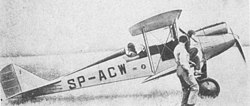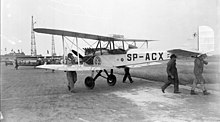PZL-5
| PZL-5 | |
|---|---|
 PZL-5 built for the European sightseeing flight in 1930 |
|
| Type: | School and sport aircraft |
| Design country: | |
| Manufacturer: | |
| First flight: |
May 1930 |
| Number of pieces: |
15th |
The PZL-5 is a single-engine training and sport aircraft developed by the Polish State Aviation Industry ( PZL ) from the 1930s.
development
At the end of the 1920s, PZL was commissioned to create a beginner's training aircraft for the first Polish flying clubs established in 1927/28. The result of the design carried out by Władysław Kozłowski and Stefan Malinowski was the first Polish sport aircraft to be produced in series. The prototype , equipped with a Gispy-I engine , flew for the first time in May 1930. Subsequently, two pre-production copies of the PZL-5 were created especially for the European sightseeing flight of 1930 , which took part in the competition with the registration numbers SP – ACW and SP – ACX , but none of them worth mentioning Placements achieved. The small series production, which started shortly thereafter, comprised eleven machines of the type designated as PZL-5a with Cirrus Mk.III engines with 71 kW (97 PS) engine power. They were used in the aero clubs as training and sports aircraft and were also called Polski Moth due to their similarity to the British De Havilland DH.60 Moth .
In response to a request from the Polish armed forces for a beginner's trainer, another redesigned prototype was equipped with a more powerful Gipsy II with 89 kW (121 hp) in 1931 and tested in July 1932 as the PZL-5bis . However, the military was not satisfied and instead opted for the RWD-8 , which was also used by the aviation clubs in the same role as the PZL-5, which is why there were only 15 copies built, some of which are still were in service at the beginning of World War II .
construction
The PZL-5 is a double-decker and made of wood. The fuselage, which is rectangular in cross-section, has plywood planking in the fuselage and upper area and fabric covering for the rest of the part. The two open and one behind the other arranged pilot positions are equipped with a double steering wheel. The two-spar wings are connected to the fuselage and to each other by I-stems, and are covered with fabric and foldable. Only the lower wings are equipped with ailerons . The normal version of the self-supporting tail unit is clad with plywood, with the rudder again covered with fabric. The three-point rear undercarriage is not retractable and consists of the main wheels with hydropneumatic damping with a split axle and a rear spur .
Military users
Technical specifications
| Parameter | Data |
|---|---|
| crew | 1-2 |
| span | 8.40 m |
| length | 6.70 m |
| height | 2.53 m |
| Wing area | 21.80 m² |
| Empty mass | 431 kg |
| Takeoff mass | 745 kg |
| drive | an air-cooled four-cylinder in- line de Havilland Gipsy I engine |
| power | 73 kW (99 PS) |
| Top speed | 164 km / h near the ground |
| Cruising speed | 125-130 km / h |
| Landing speed | 70 km / h |
| Climb performance | 2.8 m / s |
| Range | 530 km |
| Summit height | 3750 m |
literature
- Wilfried Copenhagen , Jochen K. Beeck: The large aircraft type book. Motorbuch, Stuttgart 2005, ISBN 978-3-613-02522-6 , p. 356
- Peter Alles-Fernandez (Ed.): Aircraft from A to Z. Volume 3. Bernard & Graefe, Koblenz 1989, ISBN 3-7637-5906-9 . P. 197
